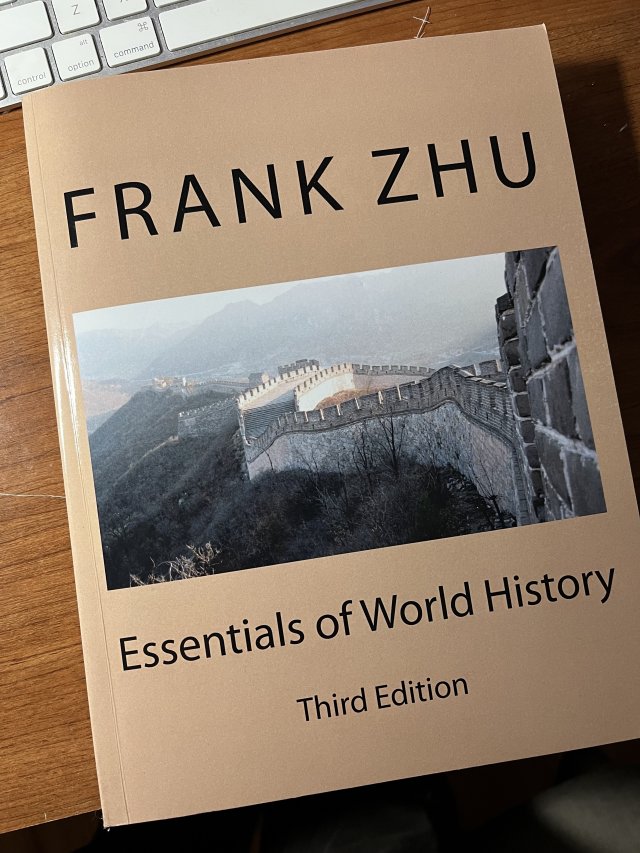____________________________________________________
Book Description
Essentials of World History is a concise history of human life since the earliest civilizations some 5,000 years ago. The book is largely intended to be used in conjunction with a lecture course in world history at the introductory level, although it is also suitable for general readers interested in world history. Because of its brevity in content, simplicity in language, and easy-to-understand organization, those readers as well as students who feel frightened by traditional bulky history textbooks may find this book particularly useful and practical in offering them essential knowledge in world history.
Essentials of World History looks at major events that happened throughout the globe in the past. Attempts have been made to maintain a balance between exhaustive detail and frustrating brevity. Narration without details is boring; but too many details are a burden for students. In this book, major events with long lasting impact receive more attention while minor ones are dealt with succinctly. Emphasis is put on those events that are more relevant to the modern world. The same principle goes with the selection of topics. The book tilts more toward social and political issues because it is believed that these issues have had more direct impact upon our modern lives.
The book consists of 30 chapters, arranged chronologically. They cover major developments throughout the world, from the earliest civilizations to the present. The whole book is divided into seven parts. The narration and analysis of each part center on a major theme. Such division helps to interconnect various historical developments so as to make them meaningful and easy to remember. Also, it helps students not to lose sight of the forest while studying separate and different chapters. Every part or chapter begins with a brief introductory remark that provides a bird’s eye view of that part or chapter. Each chapter ends with review questions in multiple-choice format. For every part, there are essay-type questions designed to encourage students to do more research. Throughout the book, great attention is paid to helping students foster a critical thinking ability. It is the author’s belief that history is of little practical use if it is not used for guiding the present and predicting the future. For students, developing historical perspectives is far more important than acquiring knowledge. Therefore, students are strongly encouraged to do the critical thinking question at the end of each chapter as written assignment, which not only requires more in-depth thinking but also helps to develop writing skills.
While this book is principally designed for college students, there are good reasons why general readers will also find it very helpful to satisfy their thirst for an understanding of world history without having to spend too much time. First, it is written in very simple language. Secondly, important events were often narrated and analyzed in comparison or contrast with others, partly for the purpose of reinforcing the memory. Therefore, few special efforts are required to memorize information. Finally, the useful features of this book, such as Chapter Highlights, Chronology, Multiple Choice Questions, and a full index, plus a comprehensive glossary, all make self-learning very easy.
Essentials of World History is a concise history of human life since the earliest civilizations some 5,000 years ago. The book is largely intended to be used in conjunction with a lecture course in world history at the introductory level, although it is also suitable for general readers interested in world history. Because of its brevity in content, simplicity in language, and easy-to-understand organization, those readers as well as students who feel frightened by traditional bulky history textbooks may find this book particularly useful and practical in offering them essential knowledge in world history.
Essentials of World History looks at major events that happened throughout the globe in the past. Attempts have been made to maintain a balance between exhaustive detail and frustrating brevity. Narration without details is boring; but too many details are a burden for students. In this book, major events with long lasting impact receive more attention while minor ones are dealt with succinctly. Emphasis is put on those events that are more relevant to the modern world. The same principle goes with the selection of topics. The book tilts more toward social and political issues because it is believed that these issues have had more direct impact upon our modern lives.
The book consists of 30 chapters, arranged chronologically. They cover major developments throughout the world, from the earliest civilizations to the present. The whole book is divided into seven parts. The narration and analysis of each part center on a major theme. Such division helps to interconnect various historical developments so as to make them meaningful and easy to remember. Also, it helps students not to lose sight of the forest while studying separate and different chapters. Every part or chapter begins with a brief introductory remark that provides a bird’s eye view of that part or chapter. Each chapter ends with review questions in multiple-choice format. For every part, there are essay-type questions designed to encourage students to do more research. Throughout the book, great attention is paid to helping students foster a critical thinking ability. It is the author’s belief that history is of little practical use if it is not used for guiding the present and predicting the future. For students, developing historical perspectives is far more important than acquiring knowledge. Therefore, students are strongly encouraged to do the critical thinking question at the end of each chapter as written assignment, which not only requires more in-depth thinking but also helps to develop writing skills.
While this book is principally designed for college students, there are good reasons why general readers will also find it very helpful to satisfy their thirst for an understanding of world history without having to spend too much time. First, it is written in very simple language. Secondly, important events were often narrated and analyzed in comparison or contrast with others, partly for the purpose of reinforcing the memory. Therefore, few special efforts are required to memorize information. Finally, the useful features of this book, such as Chapter Highlights, Chronology, Multiple Choice Questions, and a full index, plus a comprehensive glossary, all make self-learning very easy.


